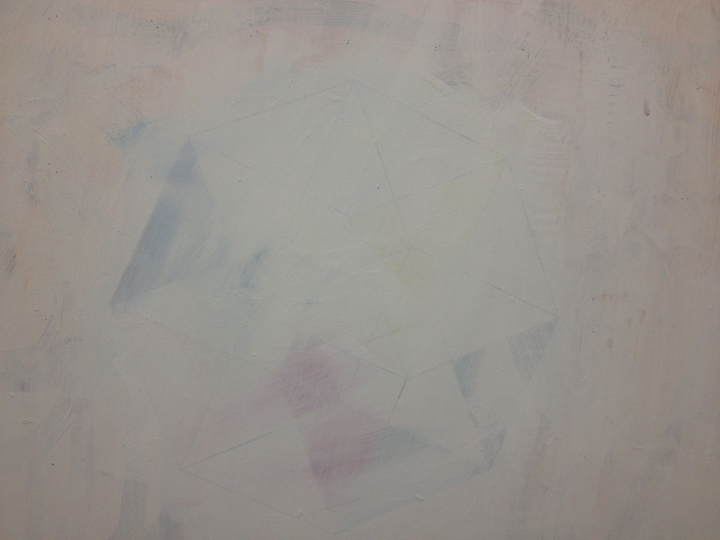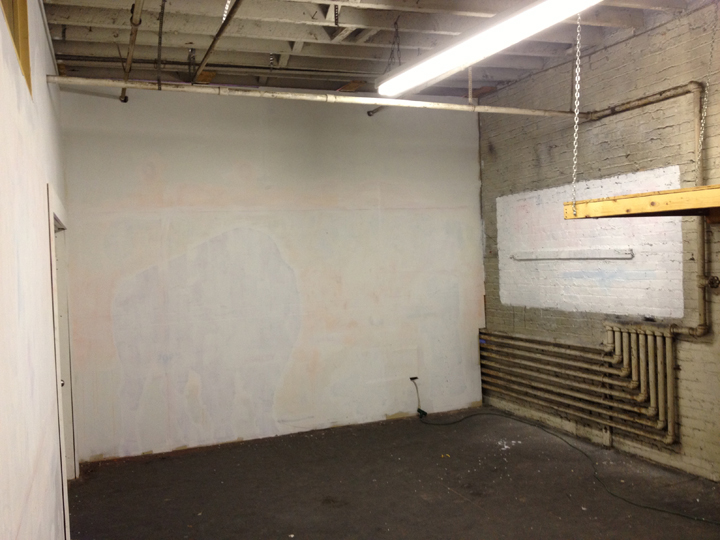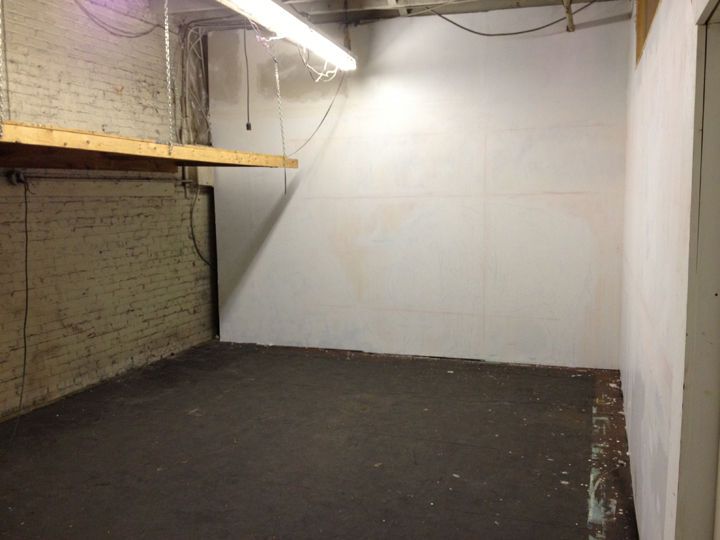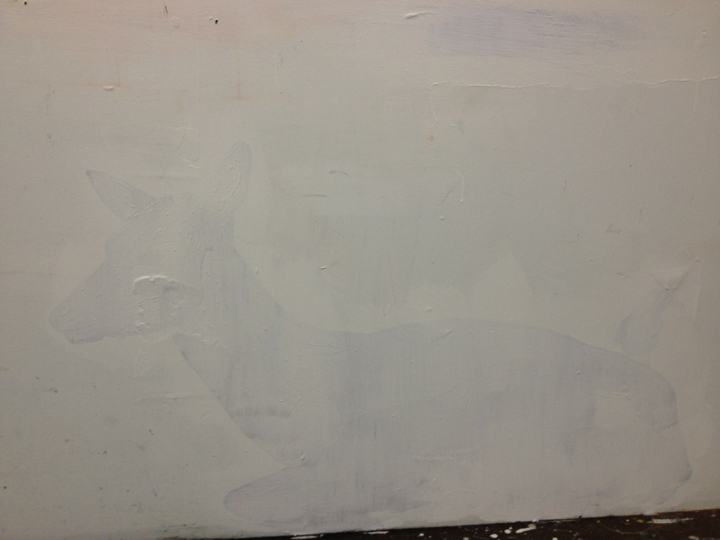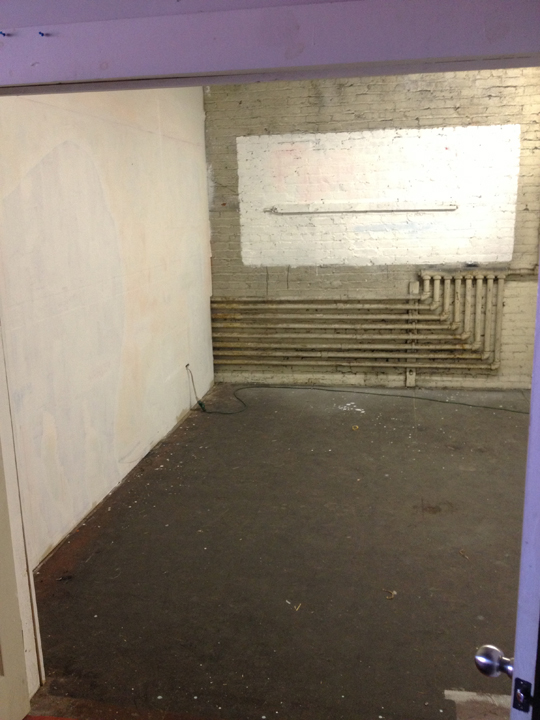Good Faith Space: An Art of Disappearing
I. You can’t buy this.
Good Faith Space
· TIMELINE: Between May and December of 2012.
· NUMBER OF SHOWS, EVENTS, HAPPENINGS: @10 (maybe more)
· PARTICIPATING ARTISTS: @TWO DOZEN (maybe more)*
In all New York City, over that period, only Banksy may have outperformed GFS. Thank goodness he’s not really an artist, and a rich tourist to boot. At least he’s great and tells the truth.
I realize it’s stupid and inconclusive to make an assertion about what the 100,000 NYC artists were doing between May and December 2013, not to mention all the dead ones on display. Maybe I missed something. It’s entirely possible, since I barely visited Manhattan. When I was in the city, I stayed in Brooklyn. Who cares about Chelsea, anymore? The only shows I really regret skipping were the fall auctions. Not that they have anything at all to do with art. They’re just dog shows. Bet on the poodle, bet on the hound. The A-list art market is where gunrunners and other operators and those who use them go to practice their craft in the open. It’s murder and slaves and drugs and worldly power. The odor reaches all the way to Williamsburg.
I guess somewhere along the line, after you realize that all your calls, email, snail mail are hacked, that you’re being filmed as you move through the canyons of stone and steel, dodging idiots in every kind of murder machine, lunatics and addicts and homeless all around you, stench and garbage underfoot on the blood-soaked concrete, ancient tunnels and worn-out crap trains, underground, stuffed with potential TERRORIST victims, and below there the caverns and bones of slaves, and all the mediocre and cowardly ideas and reactions floated around and above you, and you look in the eyes of all those supposedly hardy New Yawkahs, and all they register is fear and fatigue and sickness and hate, you realize almost everybody doesn’t really give a shit anymore. It’s all about the next fix: …Buncha addicts, killin’ themselves and anything in the way for one big score, after which they plan on cashing in and turning tail, like the soon-to-be-ex-Mayor.
Oh, the cops are ready to rumble, for sure. The rich fucks (from all over the world) all walk around like they own the place. The mercenaries guard all the palace-hi-rise residential buildings and offices. You can feel it all over the island now. It’s been true from the get-go, but there have been many beautiful anomalies, along the way. The Big Apple is an Occupied Zone, a couple clicks just shy of all-out class warfare, and I mean a shooting war, a burning and breaking war. Sandy was a warning. People are starving, inches from living in the cold, unforgiving streets, or already there, and Bloomberg can’t wait to get out of town, praying no crazy person with a beef guns him down before he boards his private jet to paradise.
I personally don’t understand how any artist worth a damn, supposedly a visionary and hypersensitive and -conscious being, pretends to be a totally myopic shoulder shrugger. How do you carry on with technical improvements, or the social life, or theory creativity and whatnot in this End-of-the-World scenario we’re living through? I am so disappointed with the artists of NYC. After a lifetime of thinking they were all like those Ab-Ex guys at the Cedar Tavern, I realized they’re mostly punk-asses, careerists who first and foremost just want a steady income to pay the brutal landlords and eat out twelve times a week with pretty, smart, traveled, drug- & drink-addled sophists. Attention spans among the beleaguered creative class typically plot a range between PTSD and SIDS. I love asking people what they’re reading. On the L, 80 percent of riders with a smart phone, laptop or electronic tablet is lost in BAD music or playing games or both. The other 20 are sleeping, nodding out from hard stuff, panhandling or committing a more serious crime.
Everyone is “busy.” You hear it over and over. It’s the most common response from all NY artsies to “What’s up.” Almost none of them actually spend any time making anything. It’s a minimal production mentality and actuality. The subways don’t run half the time, the roads are clogged, and moving anything substantial from A to B is epic. Worse, all the old concepts, especially those shopworn Marxian critiques and deconstructions, have been hollowed out and used for car commercials. Foucault is like, “I know, I know, I know, man!” The costs of studios mean that trust fund babies, (high-pay) day-jobbers, students on loans and “media artists” working in advertising services or internet or photo shops or print businesses, real estate factories, whatever, are the ones who have the juicy spots. Everything is about tricks and finish. The signature style is hungover. Hacks abound, the grim do-it-over-and-over mutts who try to convince you that a REAL artist plays broken records until a new tube of paint changes everything. You can visit their galleries or studios every ten years and get déjà vu. The clever ones know this, and their work is about keeping you on your toes with tactical variations and dopey medium-hopping (yawn).
Why anyone pretends to give a shit about anything outside Bushwick (or even further out) is beyond me. Merit and risk aversion are roughly the same quality here. Getting a straight answer from any artsy is almost impossible. Jerry Saltz still terrifies and seduces the dummies. Most of the great art beat writers are gone, and that’s not just an NYC problem. They’ve been strangled and left to die by the media monopoly. Clearly there are loads of blogs, but those lies told the FCC and other regulators and bought by a cowed or apathetic public – that NEW MEDIA meant it was cool to give the 99% of the SPECTRUM to the Corporations – have murdered free public thought and the pros who used to referee-mediate the culture scrum. Ed Murrow? LOL. Finding any two people following the same thread is not impossible. They’re couples. Twitter provides the closest thing to a beret and smock hang IRT, but the 140 characters regime is the MRSA of discourse. Ryan Trecartin and Gaga are gods to the tweety-insta-face-people. They spend all their “spare” time hooking up via Tender and the other Goodbar sex apps. Plus, you never know who’s a plant.
The NY art world is a universe of constellations, dominated by the 1%, which is absolutely mediocre and obvious, spewing waste everywhere, hiding from any accountability, and referring to itself as great in the company of sycophants and similars. It’s a drag to realize you’re living in East Germany without a Wall to blame, and Dallas and Dynasty 24/7 on the fucking TV. But who are you gonna complain to, Mac? The Ecuadorians on the L? Nine out of ten professors are like pimp-beaten-ho’s. The biggest liars are all the jerks who cry in their beers, “Nobody coulda seen this comin’!”
You didn’t hear a word about Pearl Harbor on December 7 this year. American history is subsumed by regularly scheduled global corporate media. It only takes one generation to collectively forget. Call it the Sideways 8 effect. The past is a waving peeling memory behind us. The future is crashing in like a Tsunami. Now depends on you, on us. A few madmen feel entitled to own Now.
The whole game is about erasure. Before long, Bill Gates will be teaching kids in schools all over the world about how he and Warren Buffet cut down the Apple tree and got Steve Jobs to invent the 89-hour work week, which will free everyone from everywhere of malaria, so you can run a production line or operate a calculator by cell phone, which will reduce overpopulation. Lloyd Blankfein will be in the Cloud by then, with his god, working hard, being effective and productive with other people’s Judgment Day, in the service of Universal Global Capitalism and Ayn Rand, flying Billionaire rocketships to the diverse stars of destiny, leaving behind this cesspool once and for all.
If you stand in the center of GFS as I did, on its last day of existence, and spin, do a 360° turn, you’ll realize that’s what the art in that room is about. The buffalo, the eagle, the sacred geometry, lovers embracing, even the drone, whitewashed – an art of disappearing, as Baudrillard suggested. This is what NYC and the sick property regime it serves do to everyone and everything. It’s the art the city deserves, a blank art for cannibals, a non-art for the creative destructive schemers who thrive in its pestilence, an art for forgetting, an art with no future, in a room waiting for its next tenant, who’ll add another coat of paint, most likely, without a second thought.
1. Ghosts, shades of memory, memories
I am introducing this text about GFS, and the project, itself. I suppose we have this all backwards. Good Faith Space is over. We’re done. The finish coat of primer white paint will be applied and the keys to the room will be returned to Standard ToyKraft, our hosts.
Introductions ordinarily happen at the beginning of things. This is the end, my beautiful friend.
Today, Lauren is photographing the project space, making a short video and panorama. I remember when you would employ several cameras, lots of connecting wires, hard drives, software and computer power to gather and prepare the documentation for dispersion. She’s doing it all via iPhone. Progress!
Not that the End of GFS is absolutely truly happening. Virtually GFS will continue, in the web version of perpetuity, which means however long the domain housing the content about the project remains online. Additionally, the players are not ended by this iteration of GFS coming to a close. Quite the contrary – all of them to my knowledge are pursuing projects solo and collective here in the city and far afield. For examples, Joe Riley just mounted an exhibit at Cooper Union, and Clemens Poole + the Hippo crew will follow with their own soon. Shane just successfully presented new work, building on his shows during BOS2013 and at GFS, in Nashville at an up-and-coming art venue. The structure of collective movement is similar to the rock’n’roll model, with band projects toggling with individual ones. It’s a healthy rotation, one that produces technical and conceptual refinement, assimilation, and regeneration.
GFS will be more than a listing on the participating artists’ CVs. The Good Faith Spacers established a spiraling configuration of shared and personal arts in a humble commons, and the potential for GFS to pop up again as a new, improved version is there. Will it happen? Who knows! Time will tell.
2. The Orb self-propelled
Not to presume to be in his head, but I believe I comprehend much of what Paul McLean programmed into the matrix that is GFS. We’ve worked together now, since the early 90s, and I guess I have the gist of what he calls 4D art. GFS is in most respects a Fourth Dimensional production. Superficially, GFS exhibited a series of art shows, happenings, artist talks, performances and installations, like any other precarious alternative multidisciplinary, contemporary arts venue would, nowadays. That’s not the whole picture, though. As soon as you establish a 4D protocol to the programming, you have created a system that moves differently than a strictly linear series of events will.
3. Emptiness is form.
In its nominal interface, Good Faith Space determines the domain in which the practicum functions. GFS pronounces itself to be a moral enterprise from the outset. While the pre-figuration of the project accepts a condition of Spirit, in a Hegelian and post-Hegelian sphere, in a phenomenological paradigm, let’s say, GFS also nominates the secular aesthetic for its foundation. “Space” is the Void in the equation, and the topology toggles consequently in the interstices of finitude and infinity. I realize this particular feature bears more discussion, but for now let’s go with it.
4. Form is emptiness (empty).
The orientation therefore is fluid, and circular. In actuality, GFS existed in a box, or more truly, a box within a box within a box in a topology. White Cube praxis was utilized without attachment, since the architecture of the project could only abstractly adhere to the strictures of the lab methodology. Our project room consisted of almost-raw, rudely cut and mounted drywall, exposed brick and pipes, haphazardly installed doors, window, and a disintegrating plank ceiling. The lighting was industrial fluorescent, with a few clip lights. Wiring was marginal. The flooring was minimal. Thousands of rooms in New York City are better appointed for the purpose of art exhibition.
A sturdy plywood platform came with the space, suspended by chains and supported with bolts and nails to the adjoining brick wall. After initially wanting to remove the unfinished thing, Paul decided to keep it. It eventually became the Novad Library, then Wilson Novitzki’s art bookstore. Periodically, it was used to store supplies and functioned as an ersatz cloakroom.
Some of the GFS program occurred in the STK theater, which was in the process of being reconditioned during the run of GFS. The presentation and Q&A for Voyage of the Hippo, the Maintenance Series performance, the Novadic gathering for “Titles R {p}REFORMIST,” the Eric Leiser screening – all happened in the big middle room, which was reconfigured for each. The STK theater amounted to a satellite to GFS during those happenings, and over the production operated by modular rules in that capacity, more or less. In one instance – the Fall Festival Fundraiser (STK)/”Picture ‘IS” (GFS) – the two entities conjoined.
More didn’t happen than did at GFS. By that I mean to say that concepts for projects were more numerous than realized ones. It’s normal. In a 4D model, however, the conceptual and the real are in some respects not differentiated as divisible. Or, to put it another way, qualitatively, the virtual and actual are not distinguishable in terms of value to the undertaking overall. For example, Paul wanted to do a number of shoots, performances and shows at GFS and in the theater that didn’t get done. I’m fairly certain, based on some conversations we had, that he essentially carried on the actual program while behaving as if the virtual one existed. In his imagination, he “sees” the virtual program elements as ghosts or apparitions in the space. Weird, right?
II. In fact, someone did buy it.
Although Lauren and Paul covered most of the project costs out-of-pocket, GFS received substantial contributions towards operational expenses. Early on, Kellogg LLC provided for rents and purchased a portfolio of Novitzki photos. Egogradients provided initial rent support. Individual artworks and zines were sold during exhibitions and commissioned, too. Guests paid entry fees for performances. The general economic architecture for provisioning GFS was rooted in the gift, co-op and free exchange formats. There were exploratory gestures at non-profit status,† and the default was for-profit (there were no GFS profits). The principles possessed an understanding of innovative or hybrid frameworks that might have emerged for GFS, if the program had been longer in duration. GFS probably will continue in some capacity as an online business, although what shape that might take is still an open question.
1. ONE
Let’s cut the bullshit. Good Faith Space has almost nothing at all to do with money. It’s one and only reason is great art. Sure, a critic might not find greatness in anything that happened there. Wait a second. Almost none of those exist, anymore. Which raises a question. What does an artist do, when art is lost? Well, GFS is one answer.
2. TWO
It’s possible to reverse engineer a machine, and impossible to reverse engineer time-based meaning without creating new reality or realities. Mapping a journey through a topology hardly constitutes a full rendering of the travelers’ experiences. Perception is measured in terms of endlessness, and value is codified through scarcity. Paul was searching for common ground. To summarize: the Art for Humans crew founded a commonwealth at 722 Metropolitan in Brooklyn – it’s what they do. Why? I could insert here in brackets [Dimensional Time] and repeat Paul’s thesis TIME IS THE ONLY OBJECT. EVERYTHING ELSE IS SUBJECT. I can remind the reader that he is pursuing a doctorate with the European Graduate School, and suggest that he has been dropping hints and leaving clues throughout the process of becoming a doctor of media philosophy, as to the nature of his struggle/mission/task (which is how I gather he perceives his action, cumulatively). Note the geometry. Shane did, and he manifested a new iconography, sharing it with us in several iterations, under the auspices of the Society for the Prevention of Creative Obsolescence. Linking GFS to Gramatica Parda at ANDLAB, “A New Dimension” as The Silver Shed, the installation in Saas-Fee, AFH Studio BK, Occupennial/Occupy with Art, The Spatial Occupation at Hyperallergic, Occupational Art School (at Co-Lab in Austin and Bat Haus in Bushwick), the Novad End of the World and Interstitial zine projects, “Dim Tim: Fallacies of Hope” at SLAG, Code Duello at chanorth and the texts composed during from 2008 or so through this one, to Good Faith Space is a monumental undertaking. I won’t even attempt it. It’s beyond me. I have my own garden to tend, and the weather is all wrong.
3. THREE
Is the good Dr. McLean designing an updated navigational tool, a modern Antikythera mechanism, or employing Metatron’s Cube for 21st century applications? Ask him. In the meantime, you can catalog the crimson chalk lines. You can deconstruct the arrangement of artworks in their four quadrants in GFS and deduce a critique or infer theory from the hand-painted signs. Superimposing the literal on the anti-property regime presented in the course of GFS operations will not yield a formulaic conclusion. The techne of GFS is not epistemological. A show title is a show title. A signature is a signature. Except when they’re not. Any associative binary you might discover or uncover will ultimately turn out to be incomplete, a fragment. I don’t know that Paul has a key to de-encrypt the code he is employing in his work, but if he does, he’s not saying, yet. Maybe the truth of GFS is unspeakable, which would explain why art is necessary, here. One thing is clear. GFS could not have occurred anywhere else, at any other time. Maybe that doesn’t matter, or is no big deal. I guess it depends on your perspective.
4. FOUR
In closing, I would add I’m quite fond of Paul’s portrait of Kittler, which was included in the SLAG exhibit. The painting is densely layered in meanings. The Kittler is a key to GFS, which is a portrait of Baudrillard, a loving one. The two (Paul & Jean) never met. I am wondering whether Paul found it easier to make art as homage to the thinker he knew, or the one whose traces are all he had to go on.
- Milo Santini
Santa Fe, NM
December 7th (Pearl Harbor Day), 2012
* It depends how you count. - Milo
† The political/free speech limitations on the NFP arts-org are flatly unacceptable, a none-too-subtle form of censorship that continues only through the permutations of powerful. They (e.g., the Koch brothers) manipulate the code with ease, generally speaking. - PJM
An Art of Disappearing
>>
“There has to be an art of becoming visible as well as an art of disappearing.” – Jean Baudrillard
“Art is kept isolated and half visible. You can seldom see much of what is being done in New York or of what has been done. Art isn’t visible in normal circumstances. New York City doesn’t want it around.” – Donald Judd
<<
4D is additive (N + 1). The following is from memory. Heidegger was correct about true time being 4 Dimensional.
White base. We start with charcoal drawings and a teaching-teachers exercise, framed as art play. A thin layer of white paint covers the first layer. I do a series of woven form paintings in black. The chalk lines are introduced. Next, we do a show of travel photos, tour photos, portraits, a continuation of DisciplineAriel. It is Wilson’s first exhibit. Jez is in a final phase before departure. He arrives with the Novad Library, and the ukulele. The presentation is laid out on a partial grid pattern. Fluorescent orange Sumi ink is applied. Isham Christie and Jez do a free radical thing, hanging a few prints and artworks. Jez is doing a dance around the artist inscription, testing himself as producer, comedian and other more hard-to-name Novad, anarchivist, gamer anti-roles. Some substantial folks from original OWS Arts and Culture come to the Christie/Bold celebration. This one is not just about art, for sure. That’s true more often than not, but by degree or theoretically the “Titles” show is a special type of gathering. We didn’t take any pictures. Dane’s exhibition follows. It’s a doozy. We took lots of pictures of that one. They tell the story. To this point, it’s everyone’s first show. Wilson and Andrew perform in the STK theatre. I’m forgetting the stages of covering the woven form paintings. One of the wf paintings, after a little Photoshop-aided refinement, becomes the GFS logo. Hahaha. Voyage of the Hippo next (white-ish orange walls). Then Shane’s show and Eric’s screening, followed by Picture ‘IS. At this point in the sequence, Shane is fulfilling the programmatic tasks of lead artist, demonstrating the methodology and providing data vis for the space. This is evidenced in his 4D geometric wall painting bridging his solo and the group show (featuring surf guru/artist Ambrose Curry, Dane, Wilson, Shane, [ME], and newcomers Ashley, Jakey, John and Timur. Over several months Lauren built the web site, gathered content and populated site sections, and performed the final documentation session, after I applied two or three coats of Guerra Paint white base. It was a beautiful moment: spinning in the middle of the room, thinking of Robert Ryman, and 1000 other things. Quite a run. It was worth dreaming at the End of the World.
I’ll share some of what streamed through in that reverie, some of which is technical. First of all, we can situate the expositions and interventions that AFH/GFS hosted and/or produced autonomously, in relation to the programmed 4D art project that unfolded on the production timeline. I had conversations with most of the artists about the wall treatments, the quadrants, the grid, etc. Those, like Dane and Shane, who painted directly on the exposed surfaces of the room, were engaged in the conversation at more depth, since the ghosts of their images remained visible after their respective shows closed. Our first action at GFS was a presentation on 4D followed by a free wall drawing session (ecogradients). The “educational” component of the practicum was primary and carries through the program. For some of the GFS artists, these were their first exhibits. The “local” in the concept wasn’t Williamsburg, Brooklyn or NYC in general. It was Bushwick. So, the project room location was problematic, or subtly dislocated. Anytime a project has a web-based feature (glocal), the project’s “local” is a function of the network and has a different set of rules, contrary to a strictly brick-and-mortar operation. We – especially for Dane’s exhibit – discussed the virtual evidence of GFS in terms of the virtual visitor to the “space” and the perception of that visitor of us in terms of modified or non-actual versions of ourselves. Documentation is not just a response to the presentation in our case. The phenomenology is far more complex. Our gear for documentation was inconsistent, compared to AFHGC or OAS/Co-Lab. Project discipline in documenting on the sequential timeline therefore was also inconsistent. So, we operated with a programmatic tension, a disparity between the experiential [IRL] and the experiential [virtual]. I would argue that the GFS program aesthetic accounts for the economies of praxis as a function of maintenance, not consistency. Professional standards or management discipline did not override pragmatism as a symptom of the circumstantial at GFS. In short, we were true to Bushwick, not Manhattan, in the NYC art market topology. Furthermore, we did our best to adhere to each other as artists within the production, not some to quasi-virtual or norm-biased critic’s programmatic indications for quality presentation (best practices, LOL). The GFS prioritization protocol was a vestigial hierarchy. The conceptual architecture was neither limited by the horizontal or vertical (as a schematic), nor enslaved to the impetus of command. Drawing on the lessons of the Regional Standard Arts Project (Santa Fe, 1992-3), maybe even starting where it left off, GFS brokered a truce between “professional” expectations and expedient tactical moves by Dark Matter artists. Our approach is a refutation of what is called loosely “emerging” in the art critical discourse and marketing materials. Fortunately, the “disagreeable”π conditions for artists working in NYC over past decades, now centuries, justifies most of our decisions on the basis of realism. It is nice to be in an historical environment that acknowledges that great work occasionally happens now in spite of systemic opposition to it. The anecdotes available for expansion on that remark are plentiful. I can share about the $4 million rat turds in the de Kooning now hanging in a Beverly Hills mansion, painted in a Manhattan cold-water flat, if anyone’s interested. The punch line is: “They speak to the authenticity” (a Getty conservator)… GFS was Old School “authentic.” For 4D purposes, however, “authenticity” is only one layer. Another is artificiality, and GFS hardly exhibits any of that, except in its virtual iteration, and even there it is minimized.
One feature of 4D production in the collective aspect is the appearance of the unresolved concept, which does not materialize. Calling such instances “failure” is incorrect. It’s a falsity that derives from misinterpreted Hegelian phenomenology (concept to object/destiny or linear pre-determination driven by force of mind in its command modality) and organizational principles. GFS was not solely focused on outcomes or output. Realization is more holistic and catholic (universal – all-directional-at-once) in our method. Apart from and/or in conjunction with art (object-making), Realization has a spiritual meaning, as well. For example, what if we decide to map or track energy in a project? We will be operating in another domain, not one subsumed exclusively to estimations of time-based material expenditures and repetitive activity translated to serve a contrived tertiary exploitation regime (like money), which is to say as labor. The premise “art for art’s sake” is not sufficient either. We are free to embrace art not as an alternative, but on its own terms. That’s exactly when art shifts into 4D. That’s exactly when art assumes the vestments of the Dream, of Eros and Chronos, plus one Thing - ART. [The remainder of this text is not included in the preview. –Milo]
∞
COMMENTARY
By Dim Tim
Every society gets the art and artists it deserves.° NYC deserves Jeff Koons. You elected Bloomberg THREE TIMES! …HOORAH… Now. The owner regime is defeated by GFS. Happens all the time, actually, but every once in a while the victory is more than nominal, and ripples through the conflict, shifting it, unsettling decided-upon outcomes. Or does it? GFS is a 4D painting. It is a collaboration – Paul’s first, he thinks, except for one painting he and a cowboy made in Pecos a long time ago. Wonder whatever happened to it? Probably painted over, just another layer. At GFS, you can still see the marks of all the stages, even in the end. If you were to database all factors in the making of this painting, that task alone would be as complex and expensive as the treatment the caves of Lascaux are getting from the French. The equation is only soluble through employment of dimensional numbers. Structurally, the method is the same as Yayoi Kusama’s latest. Man. Those two universes are not the same. Art isn’t only math. Why make art where no one can see [IT]? Why point in the other direction, pushing attention over there, and not here? Why send the signal asymmetric to the irruption? Calculating sentience is not exact science. I get it, but America isn’t native to me. I’m virtual-native. America is disappearing, like an art. Forget Baudrillard.
∞
ENDNOTE:
[Baudrillard, Fatal Strategies]
I think that there’s an essence of the dream, as of all things, that is to say, an ideal figure whose illusive power has been stolen from us by psychoanalysis. I think there’s a form of appearance, an ideal figure of appearance whose power of illusion has been ravished from us by interpretation.
(Pages 142, -3, -4)
π Judd.
° Paraphrasing Lascussagne. - Milo






